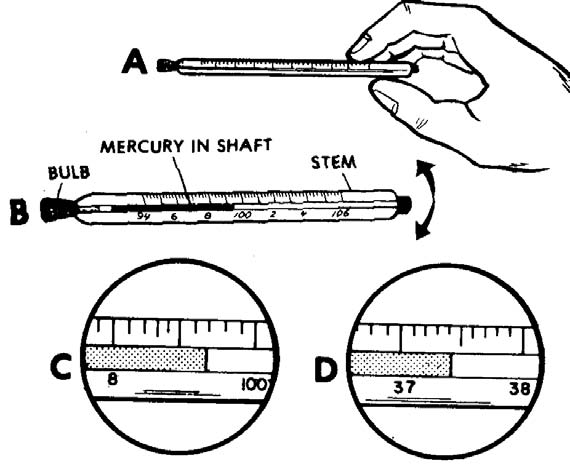Reading the glass thermometer (that is, determining the temperature shown) is done by holding the thermometer horizontally by the stem end (the end opposite the bulb) at eye level and rotating the thermometer until the mercury in the shaft can be clearly seen. This procedure is discussed below.
a. Hold the Thermometer at Eye Level.
You must hold the thermometer at the end of the stem, not the bulb end. (If you held the bulb end, your body heat could cause the temperature reading to increase if the temperature of your fingers is greater than the temperature shown on the thermometer.) Normally, the end of the thermometer is held with the fingertips of the right hand as shown in figure 2-1 A. The thermometer should be held at eye level to make reading easier.

A Holding the thermometer.
B Rotating the thermometer.
C Reading the Fahrenheit thermometer.
D Same temperature on a Celsius thermometer.
NOTE: In order to assist you with reading the patient’s temperature, most thermometers have an arrow pointing to the line denoting the average normal body temperature (98.6º F or 37º C). Additional information concerning conversion between the Fahrenheit and Celsius temperature scales is presented in MD0900, Basic Mathematics.
b. Rotate the Thermometer.
The stem of the thermometer is not perfectly round. Its flattened areas act as a magnifying glass to make the hollow shaft in the stem appear larger. (The flattened areas also keep the thermometer from rolling off a flat surface.) Using your fingertips, slowly rotate the thermometer back and forth until the mercury in the shaft is clearly visible (see figure 2-1 B). The column of mercury will appear to be silver in color and the rest (empty part) of the shaft will appear whitish. The column of mercury should be visible just above the numbers.
c. Locate the Nearest Temperature Mark.
There are several temperature markings (lines) on a thermometer. Identify the marking that is closest to the point where the mercury in the shaft stops (where the silver meets the white).
d. Determine the Temperature Reading.
The method you use to determine the temperature reading of the mark you selected in the previous step depends upon whether you are using a Fahrenheit thermometer or a Celsius thermometer.
(1) Fahrenheit thermometer. On a thermometer that uses the Fahrenheit temperature scale, each long mark shows a whole degree of temperature. There are four shorter lines between each pair of long lines. These shorter lines show an increase of two-tenths of a degree Fahrenheit (0.2ºF).
For example, the first short mark past (to the right of) the 98ºF mark shows a temperature reading of 98.2ºF. The second mark shows a reading of 98.4º F. The third mark is 98.6ºF and the fourth is 98.8º F. The next mark is a long line and represents a reading of 99o F. In figure 2-1 C, the temperature reading is 99.4º F.
(2) Celsius thermometer. Like the Fahrenheit temperature, each long line on a thermometer using the Celsius scale denotes a whole degree of temperature. On the Celsius scale; however, there are nine shorter marks between each pair of long marks. Each small mark shows an increase of one-tenth of a degree Celsius (0.1º C).
For example, the third short mark past the 38º C line denotes a temperature reading of 38.3ºC. Figure 2-1 D shows the same temperature as figure 2-1 C using a Celsius scale thermometer. The Celsius reading is 37.4º C.
